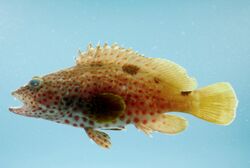Biology:Pseudorhabdosynochus monaensis
| Pseudorhabdosynochus monaensis | |
|---|---|
| File:Parasite150040-fig14 Pseudorhabdosynochus monaensis Dyer, Williams & Bunkley-Williams, 1994 - FIGS 106-111.tif | |
| Sclerotised parts | |
| Scientific classification | |
| Domain: | Eukaryota |
| Kingdom: | Animalia |
| Phylum: | Platyhelminthes |
| Class: | Monogenea |
| Order: | Dactylogyridea |
| Family: | Diplectanidae |
| Genus: | Pseudorhabdosynochus |
| Species: | P. monaensis
|
| Binomial name | |
| Pseudorhabdosynochus monaensis Dyer, Williams & Bunkley-Williams, 1994
| |
Pseudorhabdosynochus monaensis is a diplectanid monogenean parasitic on the gills of the rock hind, Epinephelus adscensionis. It has been described by Dyer, Williams & Bunkley-Williams in 1994[1] and redescribed by Kritsky, Bakenhaster and Adams in 2015. [2]
Description
Pseudorhabdosynochus monaensis is a small monogenean, about 700 µm in length. The species has the general characteristics of other species of Pseudorhabdosynochus, with a flat body and a posterior haptor, which is the organ by which the monogenean attaches itself to the gill of is host. The haptor bears two squamodiscs, one ventral and one dorsal. The sclerotized male copulatory organ, or "quadriloculate organ", has the shape of a bean with four internal chambers, as in other species of Pseudorhabdosynochus.[3] The vagina includes a sclerotized part, which is a complex structure.
Diagnosis
Kritsky, Bakenhaster & Adams (2015) wrote that P. monaensis is easily distinguished from other species of Pseudorhabdosynochus of the western Atlantic Ocean by its unique vaginal sclerite. Other features defining the species include the elongate ventral bar with a minimal medial constriction and a male copulatory organ having a comparatively long cone.[2]
Hosts and localities
The type-host and only recorded host of P. monaensis is the rock hind, Epinephelus adscensionis (Serranidae: Epinephelinae). The type-locality and only locality is Rock ridges off Playa Sardinera, Mona Island, Puerto Rico.[1][2]
References
- ↑ 1.0 1.1 Dyer, William G.; Williams, Ernest H.; Bunkley-Williams, Lucy (1994). "Pseudorhabdosynochus monaensis n. sp. (Monogenea: Diplectanidae) on Rock Hind from Mona Island, Puerto Rico". Journal of Aquatic Animal Health 6 (1): 59–63. doi:10.1577/1548-8667(1994)006<0059:PMNSMD>2.3.CO;2. ISSN 0899-7659.
- ↑ 2.0 2.1 2.2 Kritsky, Delane C.; Bakenhaster, Micah D.; Adams, Douglas H. (2015). "Pseudorhabdosynochus species (Monogenoidea, Diplectanidae) parasitizing groupers (Serranidae, Epinephelinae, Epinephelini) in the western Atlantic Ocean and adjacent waters, with descriptions of 13 new species". Parasite 22: 24. doi:10.1051/parasite/2015024. ISSN 1776-1042. PMID 26272242.

- ↑ Kritsky, D. C. & Beverley-Burton, M. 1986: The status of Pseudorhabdosynochus Yamaguti, 1958, and Cycloplectanum Oliver, 1968 (Monogenea: Diplectanidae). Proceedings of the Biological Society of Washington, 99, 17-20. PDF

Wikidata ☰ Q3160515 entry
 |


